
A growing population is generally seen as essential for us to survive as a species, a concept deeply engrained in early human civilization. The worship of fertility-inspired art and religion dates back 30,000 years, specifically to a fertility goddess sculpture with exaggerated female reproductive anatomy—the famous Venus of Willendorf.
Today, we think of ourselves as less of a gift from the goddess and more the legacy of our parents, but we are so much more than their chromosomes. Environment, or nurture, plays a big role in shaping us into the people we are. Our character of the day is 育 (yù), meaning both "to give birth" and "to nurture, educate".
As you might imagine, the linguistic aesthetics of birth are as old as human history. On the oracle bones, the character for "birth" is quite self-explanatory. On the top of the character is the shape of a woman, on the bottom is an upside-down baby. Together, it creates the scene of a woman in labor.
Sometimes, in the top half the woman takes the simplified form of "人" (rén, people), other times it is the complicated " 每 "(měi, here indicating a woman wearing hair accessories, a usage lost in modern Chinese). Three dots were later added at the bottom of the character, which refer to the spilled blood of labor.
Later still, as the characters developed, their pictographic quality gave way to evolved forms that were more standardized and easier to write.
The simpler version of the word became 后 (hòu); a character that evolved to have the meaning of both birth and a title—equivalent of that of sovereign. This as well as the fact that 后 was the title of the chief of a matriarchal tribe has led scholars to believe that there was a connection between fertility and power. This usage is still in today's language, as in 王后 (wánghòu, queen) and 皇后 (huánghòu, empress).
Beware that in simplified Chinese 后 also means "after, back" or "behind", as in 先后 (xiānhòu, before and after); but in traditional Chinese, the different meanings are represented by two different characters: 后 and 後 (hòu).


















































